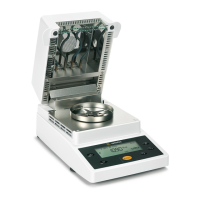14
Basic Principles
Purpose
The moisture analyzer can be used for
quick and reliable determination of the
moisture content of materials of liquid,
pasty, and solid substances using the
thermogravimetric method.
Material
The moisture of a material is often
mistakenly equated to its water content.
In fact, the moisture of a material
includes all of the volatile components
which are emitted when the sample is
heated, irrespective of the type of
material. Among such volatile
substances are:
– Water
– Fats
– Oils
– Alcohols
– Organic solvents
– Flavorings
– Volatile components, products of decom-
position (when a sample is overheated)
There are many methods for determining
the moisture content of a substance.
Basically, these methods can be divided
into two categories:
When absolute methods are used, the
moisture content is directly determined
(for example, as a weight loss registered
during the drying routine). These
methods include oven drying, infrared
drying, and microwave drying. All three
of these methods are thermogravimetric.
When deductive methods are used, the
moisture content is indirectly deter-
mined. A physical property related to the
moisture in the substance is measured
(e.g., conductivity). These methods
include capacitive and spectroscopic
approaches.
Thermogravimetry is the process of
determining the loss of mass that occurs
when a substance is heated. In this pro-
cess, the sample is weighed before and
after being heated, and the difference
between the two weights is calculated.
In a conventional drying oven, circulat-
ing hot air warms the sample from the
outside to the inside. Efficiency is lost
during drying because as the moisture
evaporates, it cools the sample surface.
By contrast, infrared rays (IR rays) pene-
trate the substance. The majority of the
rays reach the interior of a sample, and
then directly heat the sample.

